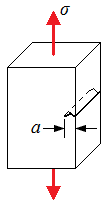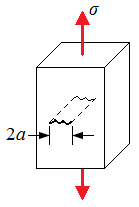

| Fracture Toughness |
| Stress intensity factor |
| K | stress intensity factor |
| f | geometry factor for the specimen and flaw |
| σ | applied stress |
| a | flaw size |
| Kc | fracture toughness |
| KIc | plain strain fracture toughness |
 |  |
| edge flaw | internal flaw |
| (Eq1) |
|
| ksi√ | in. | = 1.0989 MPa√ | m |